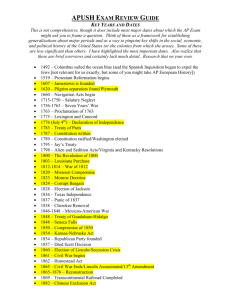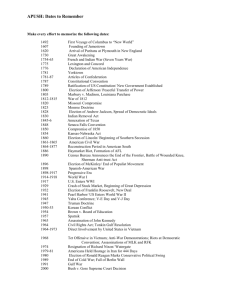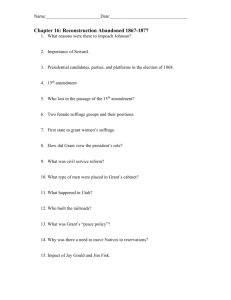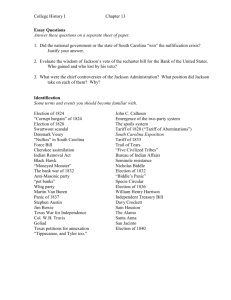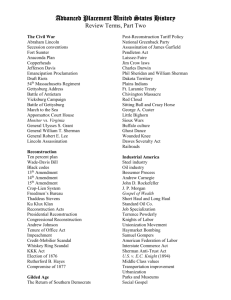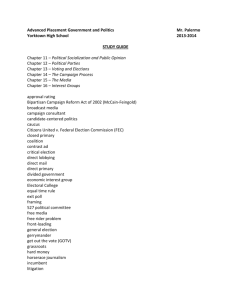APUSH ID's 2009 - Main
advertisement
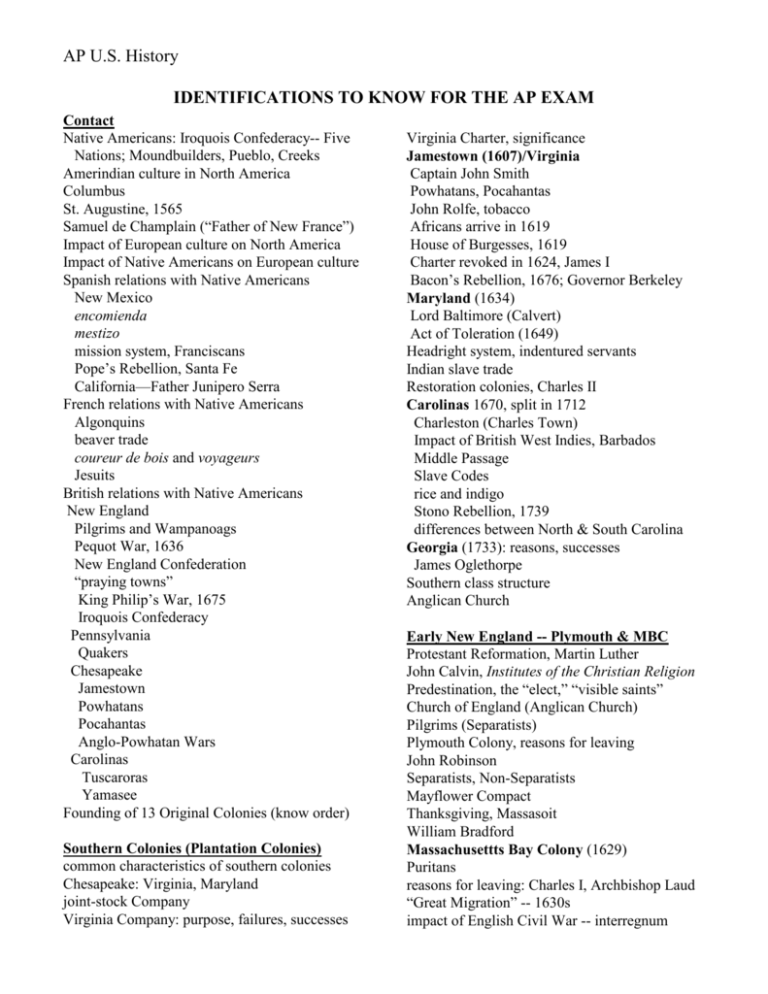
AP U.S. History IDENTIFICATIONS TO KNOW FOR THE AP EXAM Contact Native Americans: Iroquois Confederacy-- Five Nations; Moundbuilders, Pueblo, Creeks Amerindian culture in North America Columbus St. Augustine, 1565 Samuel de Champlain (“Father of New France”) Impact of European culture on North America Impact of Native Americans on European culture Spanish relations with Native Americans New Mexico encomienda mestizo mission system, Franciscans Pope’s Rebellion, Santa Fe California—Father Junipero Serra French relations with Native Americans Algonquins beaver trade coureur de bois and voyageurs Jesuits British relations with Native Americans New England Pilgrims and Wampanoags Pequot War, 1636 New England Confederation “praying towns” King Philip’s War, 1675 Iroquois Confederacy Pennsylvania Quakers Chesapeake Jamestown Powhatans Pocahantas Anglo-Powhatan Wars Carolinas Tuscaroras Yamasee Founding of 13 Original Colonies (know order) Southern Colonies (Plantation Colonies) common characteristics of southern colonies Chesapeake: Virginia, Maryland joint-stock Company Virginia Company: purpose, failures, successes Virginia Charter, significance Jamestown (1607)/Virginia Captain John Smith Powhatans, Pocahantas John Rolfe, tobacco Africans arrive in 1619 House of Burgesses, 1619 Charter revoked in 1624, James I Bacon’s Rebellion, 1676; Governor Berkeley Maryland (1634) Lord Baltimore (Calvert) Act of Toleration (1649) Headright system, indentured servants Indian slave trade Restoration colonies, Charles II Carolinas 1670, split in 1712 Charleston (Charles Town) Impact of British West Indies, Barbados Middle Passage Slave Codes rice and indigo Stono Rebellion, 1739 differences between North & South Carolina Georgia (1733): reasons, successes James Oglethorpe Southern class structure Anglican Church Early New England -- Plymouth & MBC Protestant Reformation, Martin Luther John Calvin, Institutes of the Christian Religion Predestination, the “elect,” “visible saints” Church of England (Anglican Church) Pilgrims (Separatists) Plymouth Colony, reasons for leaving John Robinson Separatists, Non-Separatists Mayflower Compact Thanksgiving, Massasoit William Bradford Massachusettts Bay Colony (1629) Puritans reasons for leaving: Charles I, Archbishop Laud “Great Migration” -- 1630s impact of English Civil War -- interregnum APUSH ID's cont. Page 2 John Winthrop: Model of Christian Charity covenant theology --“City on a hill” Puritan (Protestant) work ethic Congregational church John Cotton townhall meetings, self-government -- voting granted to church members, 1631 Cambridge Platform (1648) Religion in MBC “visible saints”, the “elect” Jeremiad Half-Way Covenant education: purpose Harvard founded, 1636 Massachusetts school of law, 1647 Dissent: Anne Hutchinson, antinomianism Quakers Roger Williams -- “liberty of conscience” Salem Witch Trials, Cotton Mather Impact of Geography on New England 3 main contributions to the American character: democracy perfectability of society Protestant work ethic Peter Minuit, New Amsterdam (1626) Peter Stuyvesant patroon system 1664, English victory Leisler’s Rebellion, NY (1691) Pennsylvania, 1681, William Penn “Holy Experiment” Quakers Religion in the Colonies Congregational Church -- Puritanism Anglican Church MD, PA, RI -- founders, established churches Maryland Act of Toleration, 1649 Great Awakening Jonathan Edwards George Whitefield Old Lights, New Lights new educational institutions Baptists Anglican Church becomes Episcopal Church College of William and Mary, 1693 Presbyterian Church The Colonial Economy Regional differences: New England, Middle Colonies, Southern Colonies mercantilism Navigation Acts Triangular Trade: know geography & products Molasses Act, 1733 Other New England Colonies Connecticut Colony (1636) -- Thomas Hooker New Haven, 1638 Fundamental Orders (1639) Roger Williams, Rhode Island (1644) New England Politics -- 17th Century New England Confederation Pequot War (1636-37) King Philip’s War, 1675; Metacom Dominion of New England Charles II Mercantilism Navigation Laws: 1st in 1651 Sir Edmund Andros “Glorious Revolution” -- 1688 English Bill of Rights “First American Revolution” Colonial Society “Old Immigration”: 1600 - 1776 royal, charter, proprietary colonies colonial political structure: Council -- upper house Assemblies (lower houses) -- most important primogeniture, entail, women lack property rights Benjamin Franklin, Poor Richard’s Almanack Phillis Wheatley Age of the Enlightenment Classical Liberalism Important Thinkers John Locke: natural rights, right to rebel Baron de Montesquieu: 3 branches deism Middle Colonies characteristics: crops, geography, immigrants New York 2 APUSH ID's cont. Page 3 Stamp Act, 1765 “No taxation w/o representation” virtual representation vs. actual representation “internal” vs. “external” taxation Stamp Act Congress non-importation Sons of Liberty, Samuel Adams repeal Declaratory Act, 1766 Townshend Acts, 1767; reaction John Dickinson, “Letters from a PA Farmer” Massachusetts Circular Letter Boston Massacre, 1770 Committees of Correspondence Tea Act (1773), British East India Co. Boston Tea Party Intolerable Acts (Coercive Acts); 1774 Quebec Act; 1774 First Continental Congress, 1774 The Association Lexington and Concord, April 19, 1775 British vs. American strengths and weaknesses Second Continental Congress, 1775 George Washington, Continental Army Declaration of the Causes & Necessity of Taking Up Arms Olive Branch Petition Battle of Bunker Hill, significance Hessians Thomas Paine, Common Sense; 1776 King George III Richard Henry Lee’s resolution of June 7, 1776 Declaration of Independence, 3 parts John Locke: natural rights philosopy Events that fostered the democratic ideal in the English Colonies House of Burgesses (1619) Mayflower Compact (1620) New England Town Meeting (after 1629) royal, charter, proprietary colonies colonial political structure: assemblies controlled spending Fundamental Orders of Connecticut (1639) New England Confederation (1643) Maryland Act of Toleration (1649) Bacon’s Rebellion (1676) “Glorious Revolution,” Bill of Rights (1689) Failure of Dominion of New England Leisler’s Rebellion (1691) “Salutary Neglect” (begins in 1713) impact on colonial government (assemblies), the economy, and religion Whig ideology Impact of the Englightenment Zenger Case (1734) Albany Congress (1754) Paxton Boys (1764) Regulator Movement (1771) (see “Road to Independence” below) Great Britain vs. France Dispute over the Ohio Valley Compare French and British colonization Iroquois vs. Hurons, significance Seven Years' War (French & Indian War) Washington’s Ohio Mission, Ft. Duquesne Albany Congress Albany Plan -- Benjamin Franklin, William Pitt Battle of Quebec Treaty of Paris, 1763 -- significance Revolutionary War Patriots vs. Tories + Loyalists Battle of Trenton, 1776 Battle of Saratoga, 1777 Valley Forge, Baron von Steuben Articles of Confederation, 1777 Franco-American Alliance, 1778 Yorktown, Lord Cornwallis Treaty of Paris (1783) social impact of the war African Americans in the war Women in the war, Abigail Adams new state constitutions Road to Independence “salutary neglect” Whig ideology writs of assistance, James Otis George Grenville, end of “salutary neglect” Pontiac’s Rebellion, significance Proclamation of 1763 Currency Act, 1764 Sugar Act, 1764 Quartering Act, 1765 3 APUSH ID's cont. Page 4 Articles of Confederation (“Critical Period”) Societal changes after the revolution end to primogeniture, entail protests over Cincinnati Society disestablishment, Virginia Statute of Religious Freedom (1786) – Jefferson Quaker abolitionism; Quock Walker case Native Americans Republican Motherhood sovereignty, republicanism features of state constitutions Maryland, cession of western land claims powers, strengths and weaknesses of Articles of Confederation Dey of Algiers Pennsylvania militia routs Congress, 1783 Newburgh Conspiracy, 1783 Land Ordinance of 1785 Northwest Ordinance of 1787 proposed Jay-Gardoqui Treaty, 1785 Shays’ Rebellion, 1787 -- significance Annapolis Conference: principle purpose, result 1780s depression Politics in the 1790s Bill of Rights adopted, 1791; know all 10! Judiciary Act, 1789 President Washington Vice-president Adams Cabinet, precedents Hamilton vs. Jefferson in political philsophy Hamilton's Financial Plan: (BE FAT) Assumption, Funding at Par, excise taxes, tariffs, BUS, arguments for & against implied powers, elastic clause (“necessary and proper” clause) loose construction, strict construction location of capital: logrolling, Dist. of Columbia Whiskey Rebellion, 1794 Washington’s Farewell Address, significance election of 1796: Adams pres., Jefferson v.p. Two-party system Federlists vs. Democratic-Republicans party leaders and supporters programs & philosophies views of foreign affairs “Mad” Anthony Wayne, Battle of Fallen Timbers Treaty of Greenville, 1795 Constitution Philadelphia Convention, 1787 Madison, “Father of the Constitution” Virginia Plan, “Large State Plan” New Jersey Plan, “Small State Plan” Great Compromise (Connecticut Compromise) 3/5's Compromise end of slave trade in 1808 checks and balances, Montesquieu Commerce Compromise Conservative safeguards, electoral college, election of Senators, appointments procedures for amendments Preamble: “We the people” Federalists and Antifederalists George Mason, Bill of Rights ratification in states, esp. Mass. NY, & VA Federalist Papers, Jay, Hamilton, Madison Federalist 10: thesis Foreign Affairs in the 1790s French Revolution, “Reign of Terror” Neutrality Proclamation of 1793 Citizen Genet Jay Treaty of 1794, result Pinckney Treaty (1795) XYZ Affair, Talleyrand “Quasi-War”: undeclared naval w ar with France; Convention of 1800 Alien and Sedition Acts, 1798 Virginia & Kentucky Resolutions, nullification, compact theory of gov’t, 1799 “High Federalists” Jeffersonian Democracy (1800-1824) election of 1800, Jefferson & Burr tie “Revolution of 1800” 12th Amendment government for the people “We are all Federalists, we are all Republicans” Sec. of Treasury Albert Gallatin maintenance of many Federalist policies reversal of certain Federalist policies 4 APUSH ID's cont. Page 5 Cohens v. Virginia, Gibbons v. Ogden, 1824 Fletcher v. Peck, 1810 Dartmouth v. Woodward, 1819 Daniel Webster Tallmadge Amendment Missouri Compromise of 1820: provisions FOREIGN POLICY: Sec.of State John Quincy Adams Rush-Bagot Treaty (1817), Great Lakes Convention of 1818, US-Canadian border est. Adams-Onis Treaty (1819) (FL Purchase Treaty) Monroe Doctrine, 1823 Judiciary Act, 1801, “midnight judges” John Marshall Marbury v. Madison, 1803, Judicial Review Justice Samuel Chase, impeachment Tripolitan War, Pasha of Tripoli, “Mosquito Fleet” Haitian slave revolt,Toussaint L’Ouverture, 1803 Louisiana Purchase: reasons, loose construction Lewis and Clark expedition, Sacajawea Burr Conspiracy/Essex Junto, 1804, Hamilton-Burr duel Burr expedition in West, treason trial Events leading to War of 1812: Order in Council impressments, Chesapeake-Leopard Affair Embargo Act of 1807, oppositon Nonintercourse Act, 1809 President Madison Macon's Bill #2, 1810 War Hawks, Henry Clay, John C. Calhoun Shawnee: Tecumseh, The Prophet Battle of Tippecanoe General William H. Harrison War of 1812: Why war against Britain rather than France? Francis Scott Key, Ft. McHenry, “Star Spangled Banner” Battle of New Orleans, Andrew Jackson Hartford Convention (1814), significance Treaty of Ghent (1815), provisions JACKSONIAN DEMOCRACY The “New Democracy,” characteristics, causes Election of 1824: popular vote, electoral vote, “corrupt bargain” Election of 1828 (Jacksonian revolution) President Andrew Jackson age of common man, gov’t by the people strong executive, King Andrew I, vetoes Jacksonian Democracy: characteristics franchise extended spoils system end of caucus system, nat’l nominating conventions more states’ rights: Charles River Bridge case, veto internal improvements (Maysville Rd) Cabinet Crisis John C. Calhoun, South Carolina Exposition and Protest, nullification Webster-Hayne Debate (1830) Jefferson Day toast “Kitchen Cabinet” Peggy Eaton Affair resignation of vice president Calhoun Nullification Crisis of 1832 “Tariff of Abominations,” 1828 Tariff of 1832 South Carolina, nullification Clay: Tariff of 1833 Election of 1832 Jackson (Democrat) Clay (National Republican) Anti-Masonic Party (1st 3rd party) nat’l nominating conventions, platforms end of the caucus system Nationalism and Sectionalism to 1828 President Monroe Sec. of State John Quincy Adams DOMESTIC POLICY “Era of Good Feelings” (appropriate term?) nationalism, economic independence single party rule Henry Clay’s American System (BIT) 2nd Bank of U.S., reversal of Jefferson’s ideas Tariff of 1816, protective internal improvements, Bonus Bill veto Panic of 1819 land legislation: new trends in acreage and price John Marshall, Federalist: decisions Marbury v. Madison, 1803 Martin v. Hunter’s Lessee, 1816 McCulloch v. Maryland, 1819 5 APUSH ID's cont. Page 6 Wilmot Proviso, 1848 Gadsden Purchase (1853) Jacksonian Economics: BUS Clay, bank recharter bill, Nicholas Biddle Jackson’s removal of deposits, Roger B. Taney, Pet banks Specie Circular, 1836, impact Charles River Bridge case, 1837 States’ rights: Maysville Road Veto Indian Removal Indian Removal Act, 1830 Black Hawk War, 1832 Seminoles (war 1835-1842) Cherokee Nation v. Georgia, 1831 Worcester v. Georgia 1832 Trail of Tears Recognition of Texas, 1837 Stephen Austin, Sam Houston Santa Anna Alamo San Jacinto Election of 1836 Whigs: origins, policies Martin Van Buren Panic of 1837 Independent Treasury Plan, “Divorce Bill” Election of 1840: candidates, characteristics Liberty Party rise of second party system: Democrats v. Whigs death of Harrison, Tyler becomes president RISE OF NATIONAL ECONOMY Sectional differences: East, West, South Industrial Revolution, impact Samuel Slater, “father of factory system” Boston Associates, Lowell, Mass. Lowell girls general incorporation laws, limited liability northern “wage slaves” “Transportation Revolution”: turnpikes, canals, rivers, railroads National Road, Lancaster Turnpike growth of cities Robert Fulton, steamboat (Clermont) 1807 Erie Canal, 1826 -- Gov. DeWitt Clinton federal gov’t land policy trend: smaller parcels Charles River Bridge Co. v. Warren Bridge Co. rise of labor leaders, 10-hour movement Commonwealth v. Hunt, (Mass.) Inventions: Eli Whitney, cotton gin, interchangeable parts Elias Howe, 1846; Isaac Singer, sewing machine John Deere, steel plow Cyrus McCormick, mechanical reaper Samuel Morse, telegraph SOCIAL REFORM Religion: Second Great Awakening: impact, reaction to deism, unitarianism, liberalism, social ills Charles Grandison Finney, Peter Cartwright, “circuit riders” camp meetings, revivalism, perfectionism influence of 2nd G.A. on frontier “the burned-over district” millenialism, Millerites (Adventists) Mormons Joseph Smith, Brigham Young, Utah wilderness utopias: Brook Farm, New Harmony, Oneida Community, Shakers, Amana Community Abolitionism: see “slavery” below” Temperance: American Temperance Union Maine law, 1851, Neal S. Dow MANIFEST DESTINY “Manifiest Destiny” Annexation of Texas, 1844 joint resolution under Pres. Tyler Election of 1844: candidates, issues Polk’s 4-Point Plan: (COIL) -- OR, CA, WalkerTariff, Independent Treasury System Oregon Territory Oregon Trail, “Oregon Fever” Oregon Treaty, 1846, 49th parallel Mexican War: (know causes, results) Slidell’s mission to Mexico. Why? Rio Grande, Nueces River, disputed territory Gen. Zachary Taylor “spot resolutions,” Lincoln Treaty of Guadalupe Hidalgo, 1848 election of 1848: Cass (pop. sov.) & Taylor 6 APUSH ID's cont. Page 7 Nat Turner revolt, 1831, Virginia mountain whites Missouri Compromise of 1820 Liberty Party, election of 1844 banning of abolitionist literature in southern mails, 1830s “gag rule,” 1836, House of Reps American Colonization Society Abolitionists: William Lloyd Garrison, The Liberator, 1831 Elijah Lovejoy American Antislavery Society Theodore Weld, American slavery as it is Wendell Phillips, “Golden Trumpet” Sarah and Angelina Grimke Sojourner Truth Frederick Douglass underground railroad: Harriet Tubman Prigg v. Pennsylvania, 1842 “personal liberty laws” Women’s Rights: Seneca Falls, 1848 Elizabeth Cady Stanton, Lucretia Mott, Susan B. Anthony Sarah & Angelina Grimke, Lucy Stone, Sojourner Truth “Republican Motherhood,” Catharine Beecher “Cult of Domesticity” Godey’s Ladybook Impact of Industrial Revolution on gender roles Education: Noah Webster, William McGuffey public education, Horace Mann Catharine Beecher Other Reformers: Dorthea Dix, treatment of the insane American Peace Society prison reform, Auburn system, Penn. system Nativism: “Old Immigration” Irish, German immigration, nativism, “Know Nothings” Literature: Transcendentalists: Romanticism Ralph Waldo Emerson Henry David Thoreau, Walden, “On Civil Disobedience” Walt Whitman, Leaves of Grass Knickerbocker group James Fenimore Cooper Washington Irving Henry Wadsworth Longfellow Hudson River School of Art, landscapes Gilbert Stuart, Charles Willson Peale Alexis de Toqueville, Democracy in America The 1850s Election of 1848, Taylor vs. Cass Free Soil Party, Van Buren Wilmot Proviso, 1848 California application for statehood, gold rush Webster’s 7th of March Speech William H. Seward (“Higher Law”) Compromise of 1850: PopFACT Henry Clay Fugitive Slave Law Nashville convention, failure Harriet Beecher Stowe: Uncle Tom’s Cabin Hinton Helper,The Impending Crisis of the South Southern defense of slavery: Bible, Aristotle, George Fitzhugh election of 1852; end of Whig Party President Pierce: “Young America” Commodore Matthew Perry goes to Japan Ostend Manifesto -- Cuba Gadsden Purchase (1853) Stephen A. Douglas (pop. sovereignty) Kansas-Nebraska Act, 1854 birth of Republican Party; end of Whigs “bleeding Kansas” New England Emigrant aid Company “Beecher’s Bibles” raid on Lawrence Slavery and the South “King Cotton” cotton gin, Eli Whitney plantation slavery, slave culture sectionalism: the 3 Souths Border South: DE, MD, KY, MO Middle South: VA, NC TN, AK Lower South: SC, FL, GA AL, MS, LA TX Slave revolts: Gabriel Prosser, 1800 revolt Denmark Vesey Conspiracy, 1822, S. Carolina 7 APUSH ID's cont. Page 8 Sumner-Brooks affair John Brown: Pottawatomie massacre Lecompton Constitution election of 1856: Republican Party (Fremont), Know-Nothing Party (Fillmore) President Buchanan (Democrat) Dred Scott decision, 1857 Chief Justice Roger B. Taney Panic of 1857 Lincoln’s “house divided” speech Lincoln-Douglas debates of 1858 (Illinois) Freeport Doctrine John Brown, Harpers Ferry raid, 1859 Election of 1860: candidates, parties, issues John Bell, Constitutional Union Party John Breckenridge, Southern Democratic Party Stephen Douglas, Northern Democratic Party Republican Party: 1860 platform, supporters Buchanan and the secession crisis Crittenden Compromise proposal Emancipation Proclamation, 1863 suspension of civil liberties: abeas corpus, Ex parte Merryman,, 1st Amendment issues Lincoln’s usurpation of Congressional powers Copperheads, Clement L. Vallandigham Republican legislation passed in Congress after secession: National Bank, tariff, Homestead Act, transcontinental railroad, land grant act Great Britain: Trent, Alabama, Laird rams, France: Emperor Napolean III Election of 1864: candidates, parties Lincoln’s 2nd Inaugural Speech: “With malice toward none, with charity for all” John Wilkes Booth Reconstruction Lincoln’s ten percent plan 13th Amendment, 1865 Ex Parte Milligan Radical Republicans: Charles Sumner, Thaddeus Stevens Wade-Davis bill (50% plan), veto Andrew Johnson and presidential reconstruction Freedmen’s Bureau, General Oliver O. Howard Black Codes 1866 elections: significance Civil Rights Act, 1866 Military Reconstruction Act, 1867 14th Amendment, 1867, provisions 15th Amendment, 1870 impeachmentm of Johnson “scalawags” and “carpetbaggers” purchase of Alaska, 1867, Sec. of State Seward President Ulysses S. Grant Compromise of 1877, provisions Hiram R. Revels & Blanche K. Bruce Redeemers (or Bourbons), Solid South Ku Klux Klan, Force Acts, 1871 Civil War Lincoln’s Inaugural Speech: purpose Cabinet: Sec.of State William H. Seward, Sec. of Treas. Salmon P. Chase, Sec. of War Edwin St Stanton Border States: MD, KY, DE, MO seceding states (first seven) Jefferson Davis, Alexander Stephens Confederate States of America South’s advantages in the war North’s advantages in the war Fort Sumter: Lincoln’s dilemna and decision volunteers and conscription, draft riots four other states secede. Why? Northern blockade (Anaconda Plan) Bull Run (Manassas) General George McClellan, Peninsula Campaign Robert E. Lee, “Stonewall” Jackson Antietam, significance of battle Fredericksburg, Dec. 1862 Chancellorsville, May, 1863 Gettysburg, July 1863, significance Vicksburg, July 4, 1863 significance Atlanta and march through Georgia -- Sherman Grant’s Virginia campaign, 1864-65 Appomattox Court House Emancipation Acts, 1862, 1863 8 APUSH ID's cont. Page 9 Post-Reconstruction African American Issues shortcomings of Reconstruction: sharecropping, disenfranchisement: poll taxes, literacy tests, “grandfather” clauses, gerrymandering “Jim Crow” -- segregation (1890s) Booker T. Washington, accommodation “Atlanta Compromise,” 1895 Plessy vs. Ferguson, 1896 -- “separate but equal” W.E.B. DuBois “talented tenth” Niagara Movement, 1905 NAACP Industrialism laissez-faire “Robber Barons” Transcontinental Railroad Union Pacific Railroad, Central Pacific Railroad Leland Stanford government subsidies to railroads workers: “paddies,” “coolies” Cornelius Vanderbilt, NY Central Railroad corrupt railroad practices: stock watering, pools, rebates, short haul/long haul John D. Rockefeller, Standard Oil horizontal integration Andrew Carnegie, vertical integration Bessemer process J. P. Morgan, interlocking directorates U.S. Steel Corporation Mechanization Thomas Edison Alexander Graham Bell The “New South” trusts, holding companies Gilded Age: 1865-1900 Corruption in the Grant administration Tweed Ring, Boss Tweed Thomas Nast Panic of 1873 and the silver issue Greenback-Labor Party 1876 election: candidates, electoral commission Compromise of 1877 assassination of President Garfield President Grover Cleveland Tariff issue (big in the 1880s) Populism: (People’s Party) free silver, 16:1 Granger laws Munn v. Illinois Wabash Case, 1886 Farmers’ Alliances Election of 1892: Cleveland, Harrison, Weaver Populist Party, Omaha Platform, 1892 Cleveland’s 2nd term: Panic of 1893 Coxey’s Army, 1893 Pullman Strike, 1894 Morgan Bond Transaction, 1895 Election of 1896: candidates, issues William McKinley, Marcus Hanna William Jennings Bryan “Cross of Gold” speech Government Regulation and Court Cases Interstate Commerce Commission, 1887 Sherman Antitrust Act, 1890 Supreme Court Cases: Munn v. Illinois, 1877 Wabash case, 1886 Labor National Labor Union, William Sylvis Great Railroad strike, 1877 Knights of Labor: Terence Powderly Haymarket Square riot, 1886 American Federation of Labor (AFL) Samuel Gompers collective bargaining strikes, boycotts, closed shop company unions Homestead strike, 1890 Pullman strike, 1894, Eugene V. Debs Lockner v. New York, 1906 Muller v. Oregon, 1908 Clayton Antitrust Act, 1914 9 APUSH ID's cont. Page 10 EXPANSION & IMPERIALISM France out of Mexico, Maximilian, 1867 Monroe Doctrine James G. Blaine, Pan-Americanism Venezuelan boundary dispute, 1895 “yellow journalism,” Hearst & Pulitzer Josiah Strong, Our Country Alfred Thayer Mahan, Influence of Sea Power on History Grover Cleveland and Hawaii Queen Liluokalani Samoan Crisis, Pago Pago U.S. Conflict with Spain over Cuba explosion of Maine Spanish-American War, 1898 Commodore Dewey, Manila Bay Theodore Roosevelt, Asst. Sec. of Navy Rough Riders, San Juan Hill (Kettle Hill) Philippines, Guam, Puerto Rico annexation of Hawaii Treaty of Paris, 1898 American Anti-Imperialist League U.S. policy toward Cuba Insular Cases Teller Amendment Platt Amendment Guantanamo Bay Naval Base U.S. policy toward Philippines protectorate Aguinaldo, Philippine insurrection U.S. policy toward China Sec. of State John Hay, Open Door Note spheres of influence Boxer Rebellion election of 1900: candidates, issues Roosevelt’s Big Stick diplomacy Panama Hay-Pauncefote Treaty, 1903 Hay-Bunau-Varilla Treaty, 1903 Panama revolution Panama Canal Venezuelan crisis, 1902 Roosevelt Corollary to the Monroe Doctrine “Colossus of the North” Dominican Republic U.S. policy toward Asia Russo-Japanese War, Treaty of Portsmouth San Francisco School Board incident Urbanization John A. Roebling, Brooklyn Bridge Louis Sullivan, skyscrapers lure of industrial jobs streetcar suburbs tenements Jane Addams, Hull House Florence Kelley Political Machines Boss Tweed Tammany Hall George Washington Plunkitt, “honest graft” “New Immigration”, Ellis Island Chinese Exclusion Act, 1882; “coolies” Victorian values (among middle class) Comstock Law, 1873; “New Morality” Social and Intellectual Movements and Ideas Social Darwinism Andrew Carnegie, The Gospel of Wealth Fundamentalism Social Gospel Salvation Army, YMCA Red Cross, Clara Barton Edward Bellamy, Looking Backward, 2000-1887 Henry George, Progress and Poverty, single tax Horatio Alger’s books for youth (rags to riches) Women’s Christian Temperance Union (WCTU) Francis Willard Carrie Nation The West 3 frontiers of the west: mining, Comstock Lode cattle raising, long drive, cowboys barbed wire, Joseph Glidden farming, Homestead Act, 1862 Plains Indians: Sioux Little Big Horn: George Custer, Crazy Horse Chief Joseph, Nez Perce Apache, Geronimo Wounded Knee, 1892 Helen Hunt Jackson, A Century of Dishonor Dawes Severalty Act, 1887 Oklahoma Land Rush, 1889 & 1892 1890 Census report: no discernible frontier Frederick Jackson Turner, frontier thesis 10 APUSH ID's cont. Page 11 Gentleman's Agreement, 1908 “Great White Fleet,” 1907 William H. Taft, “dollar diplomacy” Wilson, “Moral Diplomacy” invasion of Mexico Pancho Villa General John “Black Jack” Pershing Prohibition of Alcohol Women’s Christian Temperance Union, Francis Willard Anti-Saloon League 18th Amendment (1919) Volstead Act (1919) Presidents Roosevelt & Taft as Progressives Theodore Roosevelt Square Deal, “three C’s” Control of Corporations anthracite coal strike, 1902 Dept. of Commerce & Labor, 1903 Northern Securities Co. case, holding co. “trust buster” Hepburn Act, 1906 consumer protection Meat Inspection Act (1906) Pure Food and Drug Act (1906) conservation Newlands Reclamation Act, 1902 national parks Panic of 1907 William Howard Taft break up of Standard Oil Split in Republican party Payne-Aldrich Tariff, 1909 Ballinger-Pinchot controversy Uncle Joe Cannon, Old Guard Republicans Roosevelt’s Osawatomie, Kansas speech Taft-Roosevelt split Bull Moose Party, campaign election of 1912: Woodrow Wilson, New Freedom Theodore Roosevelt, New Nationalism Eugene V. Debs, Socialist Party Progressivism Populist ideas that carry forward “muckrakers” Progressive agenda: anti-trust, anti-political machines, improved living conditions democracy, efficiency, social justice Pre-1900 critics (of the Gilded Age) Jacob Riis, How the Other Half Lives socialists Lester Frank Ward Richard Ely muckrakers Lincoln Steffens, The Shame of the Cities Ida Tarbell, History of the Standard Oil Co. John Spargo, The Btiter Cry of the Children Upton Sinclair, The Jungle Progressive Activists Jane Addams Florence Kelley Political Reforms Robert LaFollette, “Wisconsin Experiment” initiative, referendum, recall direct primary, direct election of Senators state income tax Hiram Johnson, California Charles Evans Hughes, NY Australian ballot (secret ballot) Galveston Texas, commission system city manager system 16th, 17th, 18th, & 19th Amendments improved conditions for workers Triangle Shirtwaist Co. fire, 1911 Muller v. Oregon, 1908 Women’s suffrage National American Woman Suffrage Asso. Carrie Chapman Catt, “Winning Plan” Alice Paul, militant tactics, ERA 19th Amendment President Woodrow Wilson as a Progressive Underwood Tariff (1913), income tax Federal Reserve Act (1913) Federal TradeCommission, cease & desist orders Clayton Antiturst Act, labor’s “Magna Carta” Federal Highways Act, 1916 Warehouse Act, 1916 Child Labor Act, 1916 Adamson Act, 1916 11 APUSH ID's cont. Page 12 Supreme Court rolls back progressive reforms Lochner v. U.S., 1905 death of Child Labor Act Schenck v. U.S., 1919 Justice Oliver Wendell Holmes, Jr. Adkins v. Childrens Hospital, 1923 Teapot Dome scandal Conservative political agenda Fordney-McCumber Tariff, 1922 Andrew Mellon, tax cuts (“trickle down”) Sec. of Commerce Herbert Hoover, trade associations McNary-Haugen Bill, vetoes election of 1928: Hoover vs. Smith Bruce Barton, The Man Nobody Knows, 1925 “The Lost Generation” F. Scott Fitzgerald, The Great Gatsby Sinclair Lewis, Main Street, Babbitt Theodore Dreisler, An American Tragedy Ernest Hemingway, A Farewell to Arms T.S. Eliot, The Waste Land Prohibition, Volstead Act, Al Capone “Americanism” KKK fundamentalists, Billy Sunday Immigration Act of 1921 National Origins Act of 1924 Sacco and Vanzetti case Scopes trial, Darrow, Bryan Consumerism: automobile, radio, movies Henry Ford, the Model T, assembly line 1913 Movies: The Jazz Singer (1927), Rudolph Valentino, Charlie Chaplin KDKA, Pittsburgh new woman, flappers Margaret Sanger, birth control impact of Sigmund Freud’s theories The “Jazz Age”: Louis Armstrong Harlem Renaissance: Langston Hughes, Claude McKay, Nora Zeale Hurston, Countee Cullen, Duke Ellington Marcus Garvey, Universal Negro Improvement Association Charles Lindbergh, Spirit of St. Louis Babe Ruth, Jack Dempsey First World War Triple Entente: Allies Triple Alliance: Central Powers Lusitania, Arabic pledge, Sussex pledge election of 1916: Hughes, Wilson, issues unrestricted submarine warfare Zimmerman Note Russian Revolution, 1917, March and Bolshevik U.S. declares war, April 1917 Creel Committee “Make the world safe for democracy” “War to end all wars” bond drives, Liberty Loans War Industries Board, Bernard Baruch Herbert Hoover, Food Administration Espionage Act, 1917; Sedition Act, 1918 Eugene Debs imprisoned IWW, “Wobblies” selective service (conscription) black migration to Northern cities General John J. (“Black Jack”) Pershing Argonne-Meuse offensive Wilson’s Fourteen Points Versailles Conference, Versailles Treaty Big Four: Wilson, George, Clemenceau, Orlando League of Nations Article X of Versailles Treaty collective security new nations, self-determination Article 231, reparations Lodge Reservations, Henry Cabot Lodge “irreconcilables”: Borah, Johnson, La Follette election of 1920: Candidates, issues Red Scare, Palmer raids strikes: 1919, coal, steel, Boston Police, Seattle General Strike inflation during World War I FOREIGN POLICY Versailles Treaty Washington Disarmament Conference Five Power Treaty Dawes Plan, 1924 Kellogg-Briand Treaty, 1928 Clark Memorandum, 1928 Hoover-Stimson Doctrine, 1931 The 1920s election of 1920: candidates, issues Warren Harding, “Normalcy” brief recession, 1920-1921 12 APUSH ID's cont. Page 13 ROOSEVELT AND THE NEW DEAL election of 1932: candidates, issues Twenty-first Amendment Brain Trust Frances Perkins, Sec. of Labor Eleanor Roosevelt Social Security Act, 1935 2nd AAA, 1938 Fair Labor Standards Act: maximum hours and minimum wage Congress of Industrial Organizations (CIO), John L. Lewis sit down strikes Dust Bowl, Okies; Steinbeck, Grapes of Wrath New Democratic party coalition: blacks, unions, intellectuals, city machines, Southern whites American Liberty League Huey Long, “Share the Wealth” Father Charles Coughlin Dr. Francis Townsend Schechter Poultry Corp. v. U.S., 1935 U.S. v. Butler, 1936 “court packing” proposal (Judiciary Act of 1937) “conservative coalition” in Congress Recession of 1937-38 Keynesian economics, deficit spending First New Deal “relief, recovery, and reform” “Hundred Days” “bank holiday” Emergency Banking Relief Act, 3/33 Civilian Conservation Corps (CCC), 3/33 Federal Emergency Relief Admin (FERA), 5/33 [Civil Works Administration (CWA), 11/33] Agricultural Adjustment Act (AAA), 5/33 Tennessee Valley Authority (TVA) National Industry Recovery Act (NIRA), 6/33 National Recovery Admin. (NRA) “Blue Eagle,” Section 7a Public Works Administration (PWA) Glass-Steagall Banking Reform Act, 6/33 Federal Deposit Insurance Corp. (FDIC) Securities & Exchange Commission (SEC), 6/34 Federal Housing Authority (FHA), 1934 Indian Reorganization Act, 1934 Second New Dea Works Progress Administration Federal Arts Project, May 1935 National Youth Administration (WPA), 1935 Rural Electrification Admi (REA), 1935 Wagner Act , 1935 National Labor Relations Board (NLRB) Revenue Act, 1935 (“soak the rich” tax) World War II Good Neighbor Policy: Montevideo Conference Buenos Aires Conference Nye Committee, “merchants of death” Neutrality Acts: 1935, 1936, 1937 totalitarianism, fascism, communism Hitler, Mussolini Spanish Civil War, 1936, Francisco Franco Japan attacks China, 1937 Chiang Kai-shek Panay incident “Quarantine speech”, 1937 Munich Conference, 1938, appeasement, Neville Chamberlain pacifism, Britain, France Austria annexed, 1938 Czechoslovakia invaded, Sudetenland, 1938-39 Nazi-Soviet Non-Aggression Pact, 1939 invasion of Poland, blitzkrieg, 1939 Axis powers Grand Alliance Neutrality Act of 1939:“cash-and-carry” revision fall of France, 1940 Battle of Britain, 1940 America First Committee, Charles Lindbergh Committee to Defend America by Aiding the Allies HOOVER ADMINISTRATION Bull market, Bear market Agricultural Marketing Act, 1929, Farm Board Wall Street Crash, Oct 1929 causes of the Depression impact of the Depression depression as an international event Hawley-Smoot Tariff, 1930 Hoover’s moratorium on international debt Reconstruction Finance Corporation, RFC Bonus Army, 1932 “Hoovervilles” deportation of Mexicans 13 APUSH ID's cont. Page 14 Smith-Connolly Antistrike Act, John L. Lewis, A. Philip Randolph Destroyer-Bases Deal, 1940 “Arsenal of Democracy” speech Lend LeaseAct, March 1941 German undeclared naval warfare Atlantic Charter, August 1941 German invasion of Soviet Union Pearl Harbor, Dec. 7, 1941 Japanese internment, Executive Order 9066 Zoot Suit riots, 1943 Midway island-hopping El Alamein, “Operation Torch” War Production Board Office of Price Administration (OPA) War Labor Board General Eisenhower, General MacArthur second front D-Day, June 6, 1944 Stalingrad, 1942-43 “Big Three” Tehran Conference, 1943 Yalta Conference, 1945 Potsdam Conference, 1945 “unconditional surrender” Iwo Jima and Okinawa Manhattan Project, J. Robert Oppenheimer Hiroshima, Nagasaki, Enola Gay decisions to use of the A-bomb genocide, “Final Solution” Nuremburg trials United Nations Bretton Woods Conference, International Monetary Fund (IMF) Soviet A-bomb, 1949 NATO, 1949; collective security Warsaw Pact, 1955 NSC-68 Korean War, Inchon, limited war Truman fires MacArthur Hydrogen bomb: U.S. & U.S.S.R., superpowers Southeast Asia Treaty Organization (SEATO) Cold War: Eisenhower End to Korean War CIA in Iran, 1953 John Foster Dulles, “massive retaliation,” brinksmanship mutual assured destruction (MAD) Khrushchev, 1955 Geneva Summit “peaceful coexistence” Hungarian uprising, 1956 Suez Canal crisis, 1956 Sputnik, 1957 NASA National Education Act (+ AP program!) Lebanon, 1958 Eisenhower Doctrine Organization of American States (OAS) Fidel Castro’s revolution, 1959 U-2 incident Eisenhower’s farewell speech, “militaryindustrial-complex” Cold War at Home: Truman & Eisenhower Smith Act, 1940 Loyalty Review Board (Truman) House Un-American Committee (HUAC) Alger Hiss case, Richard Nixon, 1948 McCarran Internal Security Bill, 1950 Rosenbergs blacklisting, “Hollywood Ten” McCarthyism COLD WAR: Truman Yalta Conference Partitioning of Germany & Korea Winston Churchill, “Iron Curtain” speech communist satellites (Eastern Europe) National Security Act, Dept. of Defense, 1947 containment, George F. Kennan Truman Doctrine, 1947 Marshall Plan, Sec. of State George C. Marshall Berlin blockade, Berlin airlift, 1948-49 fall of China, 1949 Mao Tse-tung Chiang Kai-shek, Formosa (Taiwan) Cold War: Kennedy “flexible response” Berlin Wall, 1961 Bay of Pigs, 1961 Cuban missile crisis, 1962 Alliance for Progress Peace Corps Nuclear Test Ban Treaty (1963) 14 APUSH ID's cont. Page 15 desegregation in federal jobs Election of 1948: “Dixiecrats” “Fair Deal” Presidential Succession Act of 1947 22nd Amendment Vietnam: Eisenhower, JFK, LBJ, & Nixon Dien Bien Phu, 1954 Ho Chi Minh, Vietminh domino theory Viet Cong, National Liberation Front (NLF) Ngo Dinh Diem Kennedy -- increase of military advisors President Johnson -- escalation Gulf of Tonkin Resolution, 1964 Tet offensive, 1968 Kent State incident, Jackson State incident Daniel Ellsberg, Pentagon Papers My Lai massacre, Lt. Calley President Nixon & Sec. of State Henry Kissinger bombing of Laos and Cambodia Vietnamization Paris Accords, 1973 fall of Saigon, 1975 Dwight D. Eisenhower: “dynamic conservatism” Interstate Highway System, 1956 maintenance of New Deal programs: Department of Health, Education and Welfare AFL-CIO merger, 1955 Jimmy Hoffa, Teamsters Landrum-Griffen Act of 1959 Brown v. Board of Education, 1954 Little Rock crisis, 1957 Civil Rights Acts of 1957 & 1960 Society “Affluent Society”: 1950-1070 baby boom growing middle class cult of domesticity re-emerges Rock’ n’ Roll, Elvis Presley Dr. Benjamin Spock, The Commonsense Book of Baby and Child Care suburbia conformity David Reisman beatniks, the Beat Generation Jack Kerouac, On The Road Jackson Pollock, abstract expressionism Cold War: Nixon détente SALT I Agreement Henry Kissinger China visit, 1972 Moscow visit, 1972 War Powers Act, 1973 Cold War & Foreign Policy: Carter Soviet invasion of Aftghanistan, 1979 Olympic boycott, 1980 “Humanitarian diplomacy” Panama Canal Treaty, 1977 Camp David Accords, Sadat and Begin Iran Hostage crisis, Ayatollah Khomeini Domestic Issues -- 1960s Election of 1960: Kennedy vs. Nixon, TV “New Frontier” eventual support for civil rights Assassination of JFK, Lee Harvey Oswald, Warren Commission The Great Society Civil Rights Act of 1964 Voting Rights Act of 1965 election of 1964: LBJ, Goldwater Michael Harrington: The Other Side of America Office of Econ. Opportunity, “War on Poverty” Elementary and Secondary Act, Head Start Medicare Immigration Act of 1965 Cold War & Foreign Policy: Reagan/Bush “Star Wars,” SDI, Strategic Defense Initiative Mikhail Gorbachev, glasnost, perestroika INF Treaty, 1987 “Revolutions of 1989”: Berlin Wall falls fall of Soviet Union, 1991 Domestic Issues & Culture: 1940s and 1950s Harry Truman: G.I. Bill, 1944 Taft-Hartley Act, 1947 “right to work laws” desegregation of armed forces, 1947 15 APUSH ID's cont. Page 16 Dept. of Housing and Urban Development election of 1968: candidates, issues 1968: “The Year of Shocks” – Tet Offensive Chicago, Democratic Party Convention riot assassinations of Robert Kennedy & MLK Richard Nixon’s “Southern strategy” Governor George Wallace moon race, Neil Armstrong Sunbelt vs. Frost belt (or Rustbelt) Earl Warren, Warren Court Miranda decision, Escobedo decision Gideon v. Wainwright Rachel Carson, Silent Spring Students for a Democratic Society (SDS) Betty Friedan, The Feminine Mystique National Organization for Women (NOW) Equal Rights Amendment (ERA) Counterculture, “Hippies,” Woodstock sexual revolution, birth control pill Andy Warhol, Pop Art Domestic Issues: Reagan “Reaganomics”: tax cut & massive increase in military spending supply side economics Sandra Day O’Connor deregulation: AT&T, airlines, trucking, savings & loan Air traffic controllers strike election of 1984: candidates, issues Iran-Contra affair, Col. Oliver North Immigration Reform and Control Act of 1986 culture war “Religious Right” defeat of the ERA, 1982; Phyllis Schlafly George H.W. Bush: 1989-1993 Panama invasion, General Noriega Clear Air Act, 1990 (also one in 1970) The Gulf War, 1991 “Desert Storm” Saddam Hussein death of Soviet Union recession in early 1990s election of 1992: Clinton, Bush, Perot Domestic Issues: 1970s Nixon, “New Federalism”, “revenue sharing” Spiro T. Agnew, resignation wage and price controls impounding, Nixon vs. Congress Environmental issues Environmental Protection Agency (EPA), gains in environmental protection Three Mile Island, 1979 election of 1972: Nixon vs. McGovern Watergate scandal, Nixon’s resignation Arab oil Embargo, OPEC President Gerald Ford, Nixon pardon “stagflation” Cesar Chavez, United Farm Workers Roe v. Wade, 1973 American Indian Movement (AIM), Wounded Knee Bill Clinton: 1993-2001 NAFTA Monica Lewinsky scandal, impeachment George W. Bush: 2001-2009 election of 2000: Bush vs. Gore 9/11 terrorist attacks, Osama bin Laden invasion of Afghanistan, 2001 invasion of Iraq, 2003 financial meltdown, 2008 Barack Obama: 2009deep recession, 2009 health care debate Black History Slavery Reconstruction: 13th, 14th, 15th Amendments Post-Reconstruction: Sharecropping, “Jim Crow” Booker T. Washington, “Atlanta Compromise” Plessy v. Ferguson, 1896, “separate but equal” W.E.B. Du Bois, NAACP great migration northward during WWI “Red Summer,”1919 Jimmy Carter amnesty for Vietnam draft dodgers deregulation of airline industry election of 1980: candidates, issues “Moral Majority,” Jerry Falwell 16 APUSH ID's cont. Page 17 Marcus Garvey A. Philip Randolph, MOWM WWII migration to urban areas in North & West desegregation of the armed forces, 1948 Brown v. Board of Education of Topeka, 1954 Rosa Parks, Montgomery bus boycott, 1955 Rev. Martin Luther King, Jr. (SCLC) Little Rock, 1957 Congress of Racial Equality (CORE) Student Nonviolent Coord. Committee (SNCC) Greensboro sit-in, 1960 Freedom Riders University of Mississippi, James Meredith March on Washington, 1963, “I have a dream” Civil Rights Act of 1964, Title VII Voting Rights Act, 1965; 24th Amendment Malcolm X, Black Muslims, Elijah Muhammad black power: Stokely Carmichael Black Panthers: H. Rap Brown Watts Riots, LA, 1965 Thurgood Marshall, associate justice affirmative action 17

